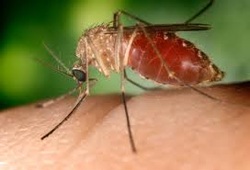
Researchers from the University of California in Davis have discovered the prevalent scent naturally produced by birds and humans, which draws in the blood-sucking Culex mosquitoes that carries the West Nile virus and other severe diseases.
The new study, published in the online issue of the Proceedings of the National Academy of Sciences, reveals why these blood-sucking insects changed hosts from fowls to humans and allows for greater advancement in disease management.
Walter Leal, an entomology professor, and Zain Syed, a postdoctoral researcher, discovered that nonanal is the dominant semiochemical that activates that insect’s sense of smell, leading them towards their hosts’ blood. A semiochemical is defined as a chemical mixture or substance that conveys messages.
“Nonanal is how they find us,” Leal stated. “The antennae of the Culex quinquefasciatus are highly developed to detect even extremely low concentrations of nonanal”. The mosquitoes detect scents with their antennae’s olfactory receptor neurons.
Birds, the primary hosts for mosquitoes, functions as the reservoir for the deadly West Nile virus, explained Leal. When virus carrying mosquitoes feed, they pass on the virus into their hosts, mostly birds, cats, dogs and humans.
Researchers from the UC Davis studied numerous compounds naturally produced by humans and birds. They gathered chemical scents from 16 adult human volunteers, representing various ethnic groups and races.
“We then determined the specificity and sensitivity of the olfactory receptor neurons to the isolated compounds on the antennae of the mosquitoes,” said Syed.
The researchers discovered that nonanal functions interactively with carbon dioxide, an identified mosquito attractant. "Nonanal, in combination with carbon dioxide, increased trap captures by more than 50 percent, compared to traps baited with carbon dioxide alone,” said Syed.
The new study, published in the online issue of the Proceedings of the National Academy of Sciences, reveals why these blood-sucking insects changed hosts from fowls to humans and allows for greater advancement in disease management.
Walter Leal, an entomology professor, and Zain Syed, a postdoctoral researcher, discovered that nonanal is the dominant semiochemical that activates that insect’s sense of smell, leading them towards their hosts’ blood. A semiochemical is defined as a chemical mixture or substance that conveys messages.
“Nonanal is how they find us,” Leal stated. “The antennae of the Culex quinquefasciatus are highly developed to detect even extremely low concentrations of nonanal”. The mosquitoes detect scents with their antennae’s olfactory receptor neurons.
Birds, the primary hosts for mosquitoes, functions as the reservoir for the deadly West Nile virus, explained Leal. When virus carrying mosquitoes feed, they pass on the virus into their hosts, mostly birds, cats, dogs and humans.
Researchers from the UC Davis studied numerous compounds naturally produced by humans and birds. They gathered chemical scents from 16 adult human volunteers, representing various ethnic groups and races.
“We then determined the specificity and sensitivity of the olfactory receptor neurons to the isolated compounds on the antennae of the mosquitoes,” said Syed.
The researchers discovered that nonanal functions interactively with carbon dioxide, an identified mosquito attractant. "Nonanal, in combination with carbon dioxide, increased trap captures by more than 50 percent, compared to traps baited with carbon dioxide alone,” said Syed.
 RSS Feed
RSS Feed